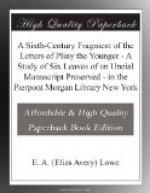[Sidenote: Conclusion]
I conclude, then, that the Morgan fragment is a piece of the Parisinus, and that we may compare with Aldus’s text the very words which he studied out, carefully collated, and treated with a decent respect. On the basis of the new information furnished us by the fragment, I shall endeavor, at some future time, to confirm my present judgement of Aldus by testing him in the entire text of Pliny’s Letters. Further, despite Merrill’s researches and his brilliant analysis, I am not convinced that the last word has been spoken on the nature of the transcript made for Budaeus and incorporated in the Bodleian volume. I will not, however, venture on this broad field until Professor Merrill, who has the first right to speak, is enabled to give to the world his long-expected edition. Meanwhile, if my view is right, we owe to the acquisition of the ancient fragment by the Pierpont Morgan Library a new confidence in the integrity of Aldus, a clearer understanding of the history of the Letters in the early Middle Ages, and a surer method of editing their text.
DESCRIPTION OF PLATES.
Nos. I-XII. New York, The Pierpont Morgan Library, MS. M. 462. A fragment of 12 pages of an uncial manuscript of the early sixth century. The fragment contains Pliny’s Letters, Book II, xx. 13—Book III, v. 4. For a detailed description, see above, pp. 3 ff. The entire fragment is here given, very slightly reduced. The exact size of the script is shown in Plate XX.
XIII-XIV. Florence, Laurentian Library MS. Ashburnham R 98, known as Codex Bellovacensis (B) or Riccardianus (R), written in Caroline minuscule of the ninth century. See above, p. 44. Our plates reproduce fols. 9 and 9v (slightly reduced), containing the end of Book II and the beginning of Book III.
XV-XVI. Florence, Laurentian Library MS. San Marco 284, written in Caroline minuscule of the tenth century. See above, pp. 44 f. Our plates reproduce fols. 56v and 57r, containing the end of Book II and the beginning of Book III.
XVII-XVIII. Oxford, Bodleian Library, Auct. L 4. 3. See above, pp. 39 f. The lacuna in Book VIII (216, 27-227, 10 Keil) is indicated by a cross (+) on fol. 136v (plate XVIIa). The missing text is supplied on added leaves by the hand shown on plate XVIIb (= fol. 144). The variants are in the hand of Budaeus. Plate XVIII contains fols. 32v and 33, showing the end of Book II and the beginning of Book III.




